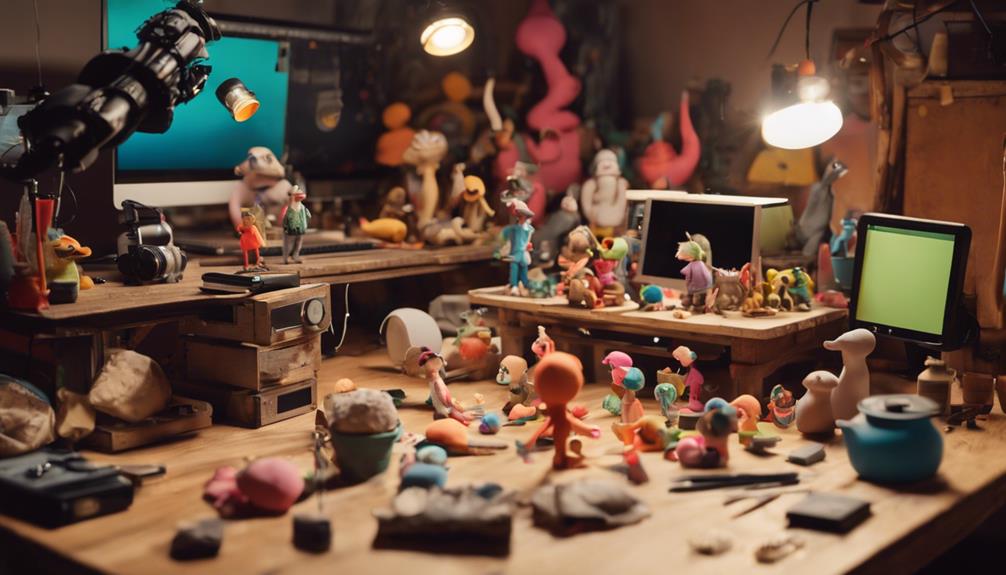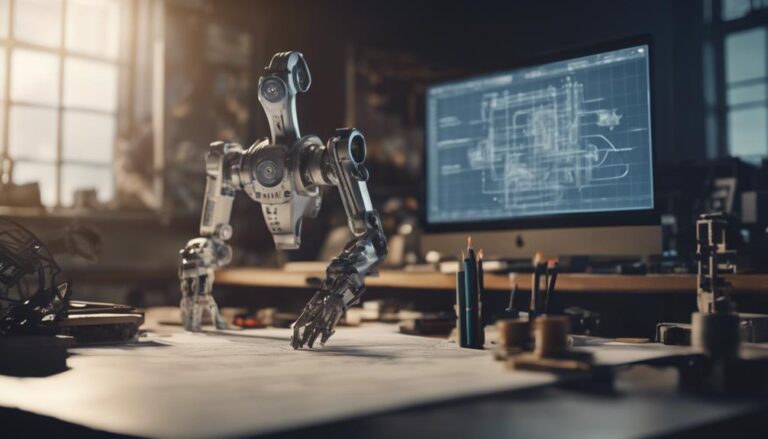What Is Stop-Motion Animation in Explainer Videos?
When creating an explainer video, you might be wondering what stop-motion animation is and how it can enhance your content. Essentially, stop-motion animation involves physical objects or characters that are manipulated frame by frame to create the illusion of movement. By leveraging everyday objects, repurposed materials, and puppetry, stop-motion brings a unique visual style to your video, capturing viewers' attention and conveying complex information in an engaging way. By mastering stop-motion techniques, you can craft compelling narratives that resonate with your audience. Now, explore the creative potential of stop-motion in explainer videos and discover how to bring your vision to life.
Key Takeaways
- Stop-motion animation in explainer videos brings complex ideas to life through physical objects and characters in a engaging narrative.
- A delicate balance between informative content and engaging narrative is required when scripting stop-motion explainer videos.
- Storyboarding is essential for creating stop-motion explainers, allowing visualization of the sequence of events and planning of animation.
- Pacing, camera angles, and character movements ensure a seamless and engaging experience in stop-motion explainer videos.
- Stop-motion animation provides a unique visual style that sets explainer videos apart from live-action or traditional animation, making them more memorable.
History of Stop-Motion Animation
Delving into the history of stop-motion animation, you'll discover it has a rich and fascinating past that spans centuries.
Early pioneers in the field of stop-motion animation experimented with various techniques, laying the groundwork for the art form. One of the earliest recorded instances of stop-motion was by French caricaturist Émile Cohl in 1908, who created a short film called "Fantasmagorie" using stop-motion techniques.
Historical milestones in stop-motion animation include the work of Willis O'Brien, who created the iconic special effects for the 1933 film "King Kong."
O'Brien's innovative use of stop-motion helped to establish the technique as a viable method for creating realistic special effects. Another significant milestone was the release of "The Nightmare Before Christmas" in 1993, directed by Henry Selick and produced by Tim Burton.
This film pushed the boundaries of stop-motion animation, showcasing the technique's potential for creating elaborate and fantastical worlds. These early innovators and milestones paved the way for the development of modern stop-motion animation techniques, allowing artists to continue pushing the boundaries of this unique art form.
Creating Stop-Motion Explainers
When it comes to creating stop-motion explainers, you'll find yourself at the intersection of technique and storytelling.
As you embark on this creative journey, you'll encounter scripting challenges that require a delicate balance between informative content and engaging narrative.
To overcome these challenges, focus on crafting a concise script that conveys your message in a clear and concise manner.
Storyboarding is another essential aspect of creating stop-motion explainers.
It allows you to visualize the sequence of events, plan your animation, and make necessary adjustments before production begins.
When creating your storyboard, consider the pacing, camera angles, and character movements to ensure a seamless and engaging experience.
Storyboarding essentials include breaking down your script into individual shots, designing your characters and props, and planning your animation sequences.
Benefits of Stop-Motion
When you use stop-motion animation, you'll find it's a cost-effective production method that allows you to create high-quality content without breaking the bank.
This technique also gives you the opportunity to develop a unique visual style that sets your work apart from live-action or traditional animation.
Cost-Effective Production Method
A well-planned stop-motion production serves as a cost-effective alternative to other animation methods. You can achieve high-quality visuals without breaking the bank.
One of the primary benefits of stop-motion is that it allows you to work within budget constraints. By creating physical sets and characters, you can avoid the costs associated with complex computer-generated imagery (CGI) and 3D modeling.
Additionally, stop-motion productions often require smaller teams, reducing labor costs and increasing production efficiency.
You can also repurpose existing materials, such as cardboard, fabric, or paper, to create your sets and characters. This approach not only saves you money but also adds a unique texture and aesthetic to your animation.
Furthermore, stop-motion allows you to shoot in a more controlled environment, reducing the need for location scouting and permits. By minimizing these costs, you can allocate more resources to other aspects of your production, ensuring a high-quality final product.
Unique Visual Style
Building on the cost-effectiveness of stop-motion, you can also leverage its unique visual style to capture your audience's attention.
This visual style is characterized by its tactile, handmade aesthetic, which can't be replicated by other animation techniques.
By utilizing stop-motion, you can create explainer videos that stand out from the crowd and leave a lasting impression on viewers.
Some of the key elements that contribute to stop-motion's unique visual style include:
* Textured characters: Stop-motion puppets can be crafted with intricate textures and details that add depth and realism to your animation.
This texture can also help to create a sense of tactility, making your characters feel more relatable and engaging.
* Vibrant backgrounds: Stop-motion backgrounds can be crafted using a wide range of materials, from painted sets to collage-style environments.
This allows you to create vibrant, stylized backgrounds that complement your characters and enhance the overall visual style of your animation.
* Dynamic camera movements: Stop-motion allows for a high degree of control over camera movements, enabling you to create dynamic, expressive shots that add energy and visual interest to your animation.
Common Objects Used
As you set up your stop-motion scene, you'll likely find yourself reaching for toys and miniatures, everyday household items, and recycled materials to bring your vision to life.
These common objects can be repurposed and reimagined to create unique characters, props, and sets.
Toys and Miniatures
What's the first thing that comes to mind when you think of toys and miniatures in stop-motion animation?
You might imagine intricate miniature worlds, meticulously crafted to bring toy storytelling to life.
This style of animation often employs toys and miniatures as characters or props to convey complex ideas in an engaging, easy-to-understand format.
Toys and miniatures offer a unique advantage in stop-motion animation, allowing you to create:
- Customized characters and props: Design and build specific toys or miniatures to fit your narrative, making them instantly recognizable and memorable.
- Scale models and sets: Construct intricate miniature worlds, replicating real-life environments or imagining fantastical ones, to serve as the backdrop for your story.
- Dynamic storytelling: Use toys and miniatures to convey emotions, actions, and interactions, bringing your narrative to life through subtle movements and expressions.
Everyday Household Items
Expanding on the possibilities of stop-motion animation, you can also repurpose everyday household items as characters, props, or set pieces to craft unique narratives.
This technique allows for a high degree of creative freedom, enabling you to transform ordinary objects into extraordinary storytelling elements.
Consider the kitchen as a treasure trove of stop-motion props.
Kitchen utensils like whisks, spoons, and spatulas can be used to create engaging characters or props.
For example, a spoon can be animated as a microphone, while a whisk can double as a dance partner.
Similarly, household items like vases, mugs, and jars can be used to create intricate set designs.
Incorporating everyday household items into your stop-motion animation can also add a layer of familiarity and warmth to your narrative.
By repurposing familiar objects, you can create a sense of nostalgia and connection with your audience.
Furthermore, using kitchen props and household items in your storytelling can also help to convey complex ideas in a simple and accessible way, making your explainer video more engaging and effective.
Recycled Materials Used
Common objects like cardboard tubes, egg cartons, and newspaper can become the building blocks of your stop-motion world.
This creative reuse of materials not only reduces waste but also adds a personal touch to your animation. When working with recycled materials, you'll discover that trash can be transformed into unique and quirky characters, sets, and props.
Incorporating recycled materials into your stop-motion animation can be achieved in various ways.
Consider the following:
- Use old CDs to create shiny, reflective surfaces for your characters' eyes or to add a touch of metallic sheen to your sets.
- Transform plastic bottles into quirky characters or use them as molds to create interesting shapes and textures.
- Repurpose fabric scraps to create colorful backgrounds, costumes, or accessories for your characters.
Best Practices for Success
Mastering the intricacies of stop-motion animation requires careful planning, attention to detail, and a well-structured approach.
As you embark on creating an explainer video using stop-motion, it's essential to develop a solid creative brief that outlines your project's objectives, target audience, and messaging.
This brief serves as a guide for your entire production, ensuring everyone involved is on the same page.
When crafting your brief, consider your brand's tone, style, and key takeaways.
This will help you create a storyboard that effectively communicates your message.
Storyboarding tips include keeping it simple, using clear visuals, and pacing your shots to maintain viewer engagement.
Break down complex scenes into manageable chunks, and don't be afraid to experiment and make adjustments as needed.
Famous Examples of Stop-Motion
Many iconic stop-motion productions have captivated audiences worldwide, leaving a lasting impact on the animation industry.
As you delve into the world of stop-motion, you'll notice that famous creators have consistently pushed the boundaries of this technique.
Some of the most notable stop-motion productions include:
* The Nightmare Before Christmas (1993): Directed by Henry Selick, this film features iconic scenes of Jack Skellington's adventures in Halloween Town.
The intricate character designs and sets showcase the versatility of stop-motion.
* Chicken Run (2000): Directed by Peter Lord and Nick Park, this film tells the story of a group of chickens' daring escape from a farm.
The comedic timing and character animation make this film a standout example of stop-motion.
* Corpse Bride (2005): Directed by Mike Johnson and Tim Burton, this film features a blend of fantasy and romance.
The stunning visuals and intricate set designs demonstrate the technical capabilities of stop-motion.
These productions demonstrate the ability of stop-motion to bring unique stories and worlds to life.
As you explore the world of stop-motion, you can draw inspiration from these iconic examples and create your own captivating animations.
Frequently Asked Questions
Can Stop-Motion Be Used in Video Marketing Campaigns?
You can leverage stop-motion animation in video marketing campaigns to boost brand storytelling and social media engagement, creating captivating, shareable content that resonates with your audience and leaves a lasting impression online.
How Long Does It Take to Create a Stop-Motion Explainer?
When creating a stop-motion explainer, you'll face time constraints, which may limit your creative freedom. However, you can still achieve complex visuals by planning meticulously, allowing 2-6 weeks for production, depending on the video's complexity and length.
Is Stop-Motion Animation Suitable for All Industries?
You'll find that stop-motion animation suits industries with creative brand tones, but may clash with formal industry norms, so consider your audience and adjust your style to ensure it aligns with your brand's voice and values.
Can I Create Stop-Motion Videos on My Smartphone?
You can create stop-motion videos on your smartphone using mobile apps that offer frame-by-frame recording, and leveraging smartphone features like high-quality cameras, stabilizers, and precise timers to produce professional-looking animations.
Are Stop-Motion Animators in High Demand Currently?
You're likely to find stop-motion animators in high demand, given industry trends favoring unique storytelling. As a skilled stop-motion animator, you'll have strong job prospects due to the increasing need for engaging, creative content across various media platforms.
Conclusion
You've now explored the world of stop-motion animation in explainer videos. By applying its unique visual language, you can captivate your audience and convey complex ideas in an engaging, memorable way. With practice and patience, you can harness stop-motion's creative potential to elevate your brand's storytelling and leave a lasting impression on viewers. By mastering this timeless technique, you'll unlock new possibilities for your explainer videos and set your brand apart.







